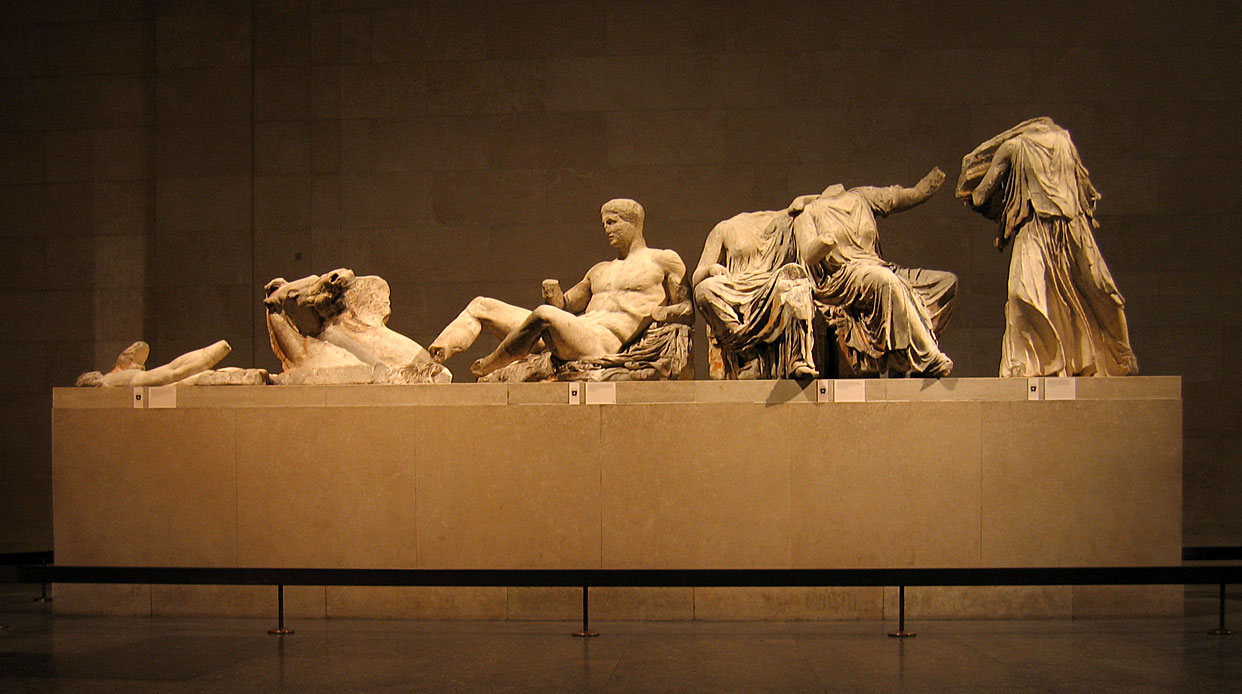We, the signed, petition to have the Parthenon Marbles returned to their home in Athens, Greece…
In order that they may be appreciated in their proper context and, most importantly, joined with the marbles that were left behind in Greece in order to present a cohesive historical and artistic whole. We believe that Greece has properly prepared for the possible return of the marbles with strict conservation techniques and state-of-the-art technology that rivals, if not surpasses, the techniques in place at the British Museum. We believe that the return of the marbles would exemplify an act of good faith and especially an appreciation of the world’s shared cultural history, and so we petition the British Museum to delay no longer and to send the marbles home.
Today we say: It’s time to give the marbles back, and bring them home.

A Sacred Space: History of the Marbles

Though the marbles are well-known today as the Elgin Marbles, after the Englishman Thomas Bruce, the 7th Earl of Elgin who stole the marbles in the early 1800s from their original site in Athens, they are more accurately called the Parthenon Marbles. This is because they are statues, inscriptions, friezes, and other architectural pieces that were originally sculpted to decorate the Parthenon, an ancient temple on the Athenian Acropolis dedicated to Athena, patron goddess of Athens.
The Parthenon itself is considered the most important monument from Classical Greece to have survived, and to this day it stands as a symbol of what many of us hold dear: ancient culture, democracy, and western civilization itself. However, it is missing part of what made it so special: the incredible classical artwork that was created specifically to honor the sacred site.
An Enthusiast Goes too Far: The Arrival of Elgin
Why did the Earl of Elgin have access to the Parthenon marbles? At the time, Greece was under the control of the Ottoman empire, and Elgin was named “Ambassador Extraordinary and Minister Plenipotentiary of His Britannic Majesty to the Sublime Porte of Selim III, Sultan of Turkey”.

Thomas Bruce, 7th Earl of Elgin
Elgin was an admirer of classical culture, and was in the process of constructing a grand country home for himself using many principles of classical architecture and art. The head architect of the project encouraged Elgin to travel to Greece and obtain special permissions from the Ottoman Empire to have drawings and casts made of the statues so that he could decorate his home with these replicas and display them to his countrymen in the hopes of improving artistic appreciation.
This was the original intent, but Elgin went even further.
Thanks to a firman–or permit–that today has fallen under much scrutiny and controversy, Elgin’s team began to hack away at the Parthenon, sawing off enormous marble statues, cutting apart grand friezes into individual chunks, and otherwise doing irreparable damage to the marbles and the structure of the Parthenon itself. Over the course of eleven years (1801-1812) Elgin’s team ripped up this sacred building’s history and had it shipped to England.
Disapproval, Even in His Own Time
Even Elgin’s contemporaries couldn’t condone his actions. Famous poet Lord Byron thought Elgin’s removal of the marbles was nothing short of looting and plundering, and made his opinion public in his poem, “Childe Harold’s Pilgrimage.”
Sir John Newport, Whig politician and Chancellor of the Exchequer of Ireland, said:
|
Edward Daniel Clark, an English clergyman, actually witnessed the removal of some marbles and said: “Thus the form of the temple has sustained a greater injury than it had already experienced from the Venetian artillery,” and, “neither was there a workman employed in the undertaking … who did not express his concern that such havoc should be deemed necessary, after moulds and casts had been already made of all the sculpture which it was designed to remove.”
A Look at the Arguments, and the Facts
The debate around the Parthenon marbles is one that still rages, and over time, many supporters of the British Museum have voiced arguments as to why the marbles shouldn’t be returned. Here we present to you four of the most popular arguments and our refutations.
1. Greece Can’t Care For The Marbles
One of the most common arguments against the return of the Parthenon Marbles is that Greece would not have the means to care for and, most importantly, conserve the marbles. Over the years, proponents of this argument have cited everything from wars to pollution as evidence for this theory. However–while it is undeniable that the Acropolis has seen its fair share of war and disrepair in the past–it is simply not true that the Greeks do not have the means to care for the marbles.

The New Acropolis Museum, opened in 2009 within sight of the Acropolis itself, currently houses and–using state of the art technology–preserves the marbles that were not taken by Elgin. The Museum, ever hopeful, has even built a room especially for the Elgin Marbles, waiting tirelessly for their return to their rightful home, and Greece has spent a great deal of money ensuring that the museum’s facilities and conservation techniques are cutting edge.
If you haven’t been to the new Acropolis Museum, it’s a beautiful modern space, designed to show the magnificent artefacts from over 2000 years ago. Moreover, the building itself is built on top of an archaeological site, with transparent flooring so visitors can truly appreciate the process that goes into conservation.
The Best Caretakers?
The British Museum can do nothing but admit that their own conservation techniques, in the years after the removal of the marbles, left much to be desired. The marbles were irreparably damaged during several attempts to “clean” them–unaware that the marbles’ original environment naturally gave them a yellowish patina over time, the British conservation teams scraped, scrubbed, and wore away at the marbles in an attempt to restore them to a white luster.
Anything to Protect History
During the Greek war for independence, Ottoman forces took over the Parthenon as a military base. When the Greeks heard that the Ottoman forces were destroying columns in the Parthenon to salvage lead–in the hopes of melting it down to make bullets–Greek forces offered up their own bullets to their enemy in exchange for the safety of the Parthenon.
2. Elgin Protected the Marbles
A similar argument claims that if Elgin had never taken the marbles from the Parthenon, they would have been destroyed either by war or by the ravages of time.
While there may be some truth to this argument, it does nothing to erase the fact that the marbles should be returned now. To put it simply, what sane person says, upon saving his neighbor’s property from a fire and caring for it briefly in the aftermath, “You’re very welcome–oh, but this is mine now”?
Greece has shown gratitude to Britain for the preservation and safekeeping of an important part of their cultural history; but does it surprise anyone that, now that Greece has resolved its major conflicts and worked hard to construct a facility worthy of the marbles, they are asking that their rightful cultural property be returned?
3. Returning the Marbles will cause a ‘Chain Reaction’
Another popular argument involving the marbles is one that we can only call a distraction. Some supporters of the British Museum claim that the marbles cannot be returned because doing so would incite a “chain reaction”–museums around the world would be emptied of their collections as other countries and cultures ask for artifacts and works of art to be returned.
The fact of the matter is that the Greeks are not demanding the return of any other artifacts from museums around the world. Greece, after all, is generally proud to have its ancient artwork displayed and admired in other countries. The marbles represent a special case because an important piece of cultural history has been quite literally severed in half, and the Greeks believe that these pieces should be rejoined in order that they can be appreciated in the fullness of their original conception and context.
Classical Enthusiast Christopher Hitchens explains:
|
One argument posed by the British Museum may be valid: the marbles as works of art and especially as pieces of history belong to the world at large, and we should all share to some extent in the cultural heritage they represent–but how can they truly be appreciated, and how may we understand that heritage, if they aren’t in their original context and aren’t even whole to begin with?
4. The Marbles Get A Larger Audience In London
While it is true that the British Museum currently has larger tourist numbers than the Acropolis museum, and thus allows more people to view the marbles there, this point is still a fallacy. If we are only concerned with the sheer number of people who can see an item, then why aren’t the marbles in Beijing? Or in the Louvre, where at least 2 million more people would see them? Why bother having any museums with important items outside of Tokyo, Delhi and Shanghai?
Surely the people in Greece have a right to view the marbles and who is to say what moving the marbles could do for their own tourism numbers? An increase of which, no one doubts, would be a great benefit to Greece as a whole.
Moreover, if the United Kingdom is leaving the European Union, they may find their own tourism numbers decreasing rapidly, especially if they install stricter entry requirements to the country. Imagine if Greeks and other Europeans wouldn’t be able to see the marbles at all!
Demands of the Public
Perhaps most telling is the response of the British public to all this argumentation and debate. When asked in 2014 through a Yougov survey whether the marbles should be returned, a whopping 77% agreed that the marbles should go back to Greece. It begs the question then, who exactly wants the marbles to stay in Britain? And why are their voices being heard, and not the majority?
Conclusion
We believe that while the debate surrounding the Parthenon Marbles remains controversial for a variety of reasons, the proper course of action is clear: the marbles should be returned to Greece, to be cared for and displayed in the Acropolis Museum, reunited with the lost halves that are awaiting them. In this way they can be viewed in their original context and appreciated in their wholeness–the incredible historical, cultural, and spiritual story they represent can be told in its entirety for the first time in hundreds of years. By signing this petition, you are supporting this long-deserved reunification, and showing the British Museum that this debate is not over, that the public believes it is time to do the right thing.
Once we have 10,000 signatures, we can get a response from the British government. At 100,000 signatures, this petition will be considered for a debate in the British parliament. If we reach 1,000,000 signatures, then we can get a response from the European Union parliament. Let’s make this a real conversation, let’s bring the marbles back home.
Show Your Support Below